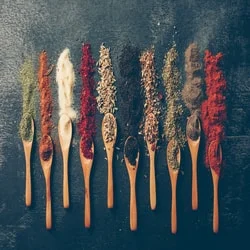~Khushi and Aadya
Indian food culture is a significant part of the Indian tradition. It consists of vivid cuisines which belong to different subcultures existing in the country. The variety in the Indian food culture comes from the diversity in climate, soil and tradition of a region due to which every cuisine includes a different set of herbs and spices. Not only the region but the religion also influences the cuisine. Since the term “Unity_in_diversity ” fits perfectly for our nation, the food culture also validates the same. The Indian cuisine partially follows a pattern of eating meals starting from snacks (or so-called ‘starters’) then the proper meal, ending with the desserts.
There are many cuisines present in the Indian culture and thus, define different staple foods of people living in different states. To talk about a few famous cuisines, we have cuisines-of-Telangana, Kashmiri_cuisine, Bengali_cuisine, etc. The main and most common ingredients used throughout the nation are whole wheat flour, rice, lentils, etc. However, when we look at the overall picture, we classify them based on the spices and the staple food ingredient used.
The unique use of herbs and spices brings out the diverse nature of Indian food recipes, culture and tradition and unites us despite all geographical boundaries. From sizzling spicy curries of North India to subtle and exotic idli sambhar of South India and from khakhra, dhokla, kachori, daal baati churma in Western India to litti chokha, rasgulla, momos, thekua in Eastern India, everyone relishes the taste of Indian cuisines.
Food-related traditions
- Eating on a Thali : Small compartments in a thali provide a variety of dishes in a single meal
- Eating with hands and making appropriate ‘niwala’: Some people find it tastier while eating with their hands
- Offering prasad to deities before meal: The food is considered to be blessed by God
- Dahi shakkar / ghee shakkar: Before commencing new ventures, it is believed to be an auspicious ritual
- The food is served on banana leaves instead of on plates especially in South India households
- Chai and meethi lassi are served in small earthen pots known as Kulhar mostly in Northern India. The idea emerged with the thought of maintaining the temperature of the beverage along with making the utensil economical and easily available.
- Turmeric Milk: It is said to have many benefits wherein it’s mostly famous for its healing properties.
These are few customs and traditions in the Indian food culture which still exist in different pockets of the country. In fact, some of the state cuisines are famous for such unique serving methods which attract people from not only different regions of India but also the tourists from other parts of the world.
Spices and Preparation
India’s cuisines are known for its spices, herbs and flavour which also adds a delicious taste in life. Herbs and spices increase the flavour, vibrant colours, aroma, essence and a pleasant taste in food. A few of the most used spices in Indian households are cumin seeds (mustard seeds), turmeric, clove, red chilli powder, black pepper, etc. Since the main flavour and uniqueness of Indian food comes from the use of spices, Indian dishes are considered to be very spicy.
A basic preparation of Indian food consists of the following steps:
- Healthy cooking methods such as steaming, broiling, grilling and roasting are preferred
- Cook foods in as little water and for as short a period as possible to preserve all vitamins present in water
- A variety of herbs and spices are used for additional flavour
However, the food tastes differently with even a minor change in the recipe. Hence, the nation along with each and every state has its own speciality even though the cuisines and the respective recipes have travelled throughout the world. Keeping in mind the same, Delhi being the capital, is said to be an amalgamation of all sorts of cultures present in the country and thus, one can find every type of Indian cuisine here.
Exports and availability in other parts of the world
India is the world’s largest producer and consumer of spices wherein 75 of 109 varieties of spices listed by Indian Standard Organization are produced in India. Being the largest producer, it exports spices majorly to USA, UK, European countries and the Middle East in significant quantities. Even after being the largest producer of spices, India also needs to import spices like ginger, cassia, poppy seeds etc. from countries like Sri Lanka, Malaysia, etc.
With the help of increasing trade between countries, Indian spices are now available in most parts of the world. This is not only due to the good relations with other nations but also due to the efficient trade policies. In addition to this, the presence of Indian people residing in different parts of the world helps the Indian culture spread and grow.
Conclusion
Indian food culture is vast and vivid in itself. It contributes to attracting tourists as well, through its alluring aroma and interesting outlook. Altogether, it’s a unique element that the nation owns and can be proud of.
Must Read: https://skchildrenfoundation.org/the-concept-of-intermittent-fasting/






2 Responses
This blog is very informative and easy to understand .Thanks for sharing!!!
Regards,
Reshu
Organic Turmeric
Organic Cardamom
Organic Pepper
Organic Dried ginger
Hi Reshma, Thank you very much for going through our blogs. It’s a pleasure to give voice to the facts and opinions for you all to read. Keep encouraging us by staying tuned to our posts and with your lovely comments.
Thanks a lot!